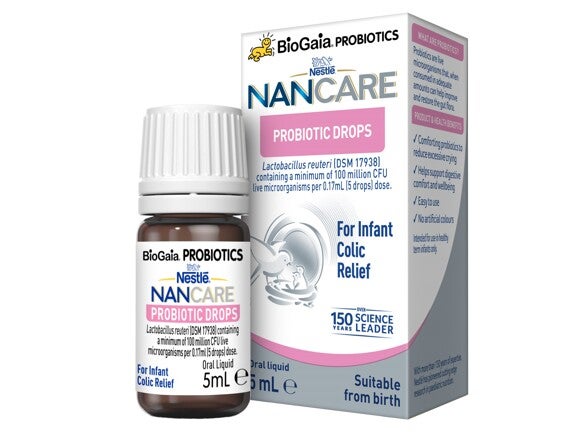What is colic?
Colic is an unexplainable unsettled period where your baby is crying for a long time, sometimes for hours, and is inconsolable. The most common definition of colic is crying ≥3 hours per day, on ≥3 days per week for ≥1 week, and that your baby is otherwise thriving and growing well1. One of the most important things you can do up front is to see your baby’s doctor, especially if your baby is excessively crying without a clear explanation for it, this is important so your doctor can rule out any serious conditions or other causes for crying, which will give you reassurance that your baby is growing healthily.
How common is colic?
Colic occurs in approximately 20% of infants and is most common during the ages of 1-5 months2,3. As babies grow and develop past this time, infant colic seems to be less common.
What are the symptoms of colic in babies?
Simply put, long periods of unexplained crying and fussiness are the primary symptoms of colic in babies, and the crying feels beyond what you would consider to be ‘normal’. The difficulty in recognising colic is that it’s relatively ‘normal’ for babies to fuss and cry – after all it’s one of their main ways to communicate with us. After checking with your doctor that what your baby is experiencing is colic, trust their support, and lean on family and friends, to help you get through this challenging time.
What are the signs your baby has colic?
Signs of colic may include:
- Your happy healthy baby – who up until now has amazed you with their calm nature – starts to cry repeatedly throughout the day and several times during the night.
- Your baby is irritable and unhappy for longer than normal.
- During this time, other physical signs might also include your baby going red in the face, clenched fists, an arched back and drawing their knees up to their tummy.
Unfortunately, this can all be normal for colic. However, it’s important that you speak to your doctor to rule out any serious conditions that may be causing the crying.
What causes colic in babies?
The cause of colic is not quite clear despite scientific efforts to uncover it. In fact, there are many theories and may likely be a multifactorial condition4. More recently, it has been identified that colicky babies may have an altered microbiota compared to non-colicky babies with less good bacteria4-6.
How is colic treated?
Once your doctor has ruled out any serious conditions or other causes for your baby’s crying, treatment is naturally the next question. As the cause is not quite clear, the treatment path is also not straightforward. For some, apart from extra comforting that your little one will appreciate, it may be a case of waiting for your little one to grow out of it over time.
There are promising results with specific lactobacillus probiotics like NAN CARE Probiotic Drops for Infant Colic Relief which features Lactobacillus reuteri DSM 17938 that have shown reduced crying time in colicky infants, especially seen in breastfed infants4,7.
How can you soothe a baby with colic?
Here are some tips you can use to help soothe your baby with colic.
- If breastfeeding, work with your health care professional to continue as it can be very comforting.
- Some babies find sucking calming, and you may find feeding your baby more frequently may help. Just be aware that over-feeding may result in tummy discomfort which won’t ease the crying.
- Talk to your doctor about possible treatment options, including specific probiotics that may help ease the crying in colicky infants including NAN CARE Probiotic Drops For Infant Colic Relief which features probiotic Lactobacillus reuteri DSM 17938.
- Gently massage your baby’s stomach in a clockwise direction, placing a warm towel on their tummy (warmth is excellent for relieving pain).
- Give your baby a warm bath.
- If you are bottle-feeding, make sure you follow the directions on pack, and you use the correct scoop and quantities of powder and water. Seek the advice of a healthcare professional before changing infant formulas.
- Gentle rocking or holding your baby in your arms or in a baby carrier or sling.
Be sure to get the support you need. Remaining calm and soothing your baby the best way you can will mean more than you think: they’ll feel your love and comfort come through in your gentle touch.
How can NAN CARE help my colicky baby?
Nestlé NAN CARE Probiotic Drops for infant colic relief contains probiotic Lactobacillus reuteri DSM 17938 which helps restore the balance of bacteria in the digestive system.
Features and benefits:
- Comforting probiotics to reduce excessive crying
- Helps support digestive comfort and wellbeing
- Suitable from birth
- No artificial colours
- Easy to use
- No refrigeration required

Always read the label and follow the directions for use.
References
1. Benninger MA. et al. Gastroenterology 2016;150:1443–1455;
2. Sung V et al. JAMA Pediatr. 2013 Dec;167(12):1150-7;
3. Vandenplas Y. et al. J Pediatr Gastroenterol Nutr 2015; 61:531-7;
4. Simonson, J. et al. MCN in Advance. 2020. Wolters Kluwer Health, Inc.;
